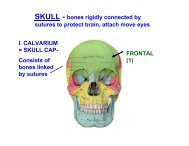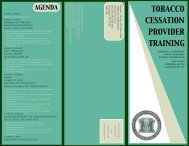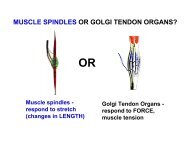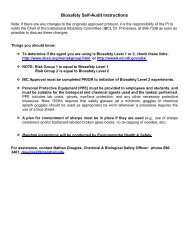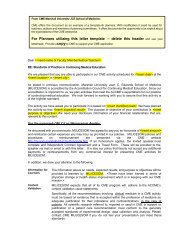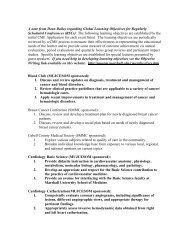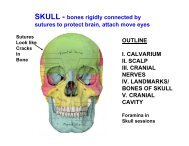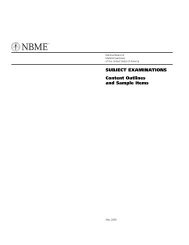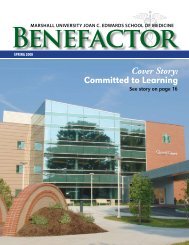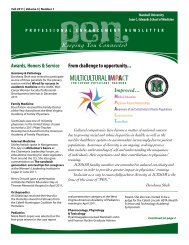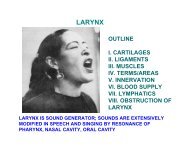FA 5 Progress Report WV-INBRE - Joan C. Edwards School of ...
FA 5 Progress Report WV-INBRE - Joan C. Edwards School of ...
FA 5 Progress Report WV-INBRE - Joan C. Edwards School of ...
- No tags were found...
You also want an ePaper? Increase the reach of your titles
YUMPU automatically turns print PDFs into web optimized ePapers that Google loves.
Program Director/Principal Investigator (Last, First, Middle): Rankin, Gary O 48remains unclear, but as in striated muscle, it is reasonable to postulate that SM titin may contributeto stiffness. Unlike striated muscle, SM cells respond to stretch in a complex manner that involvesan extensive change in morphology and reorganization <strong>of</strong> their cytoskeleton. SM cells may thusrespond to changes in mechanical load with alterations in titin expression. In this study, titinexpression was determined (qRT-PCR) in A7r5 cells which were exposed to cyclic (dynamic) orstatic (step) stretch. There was an early decrease in expression <strong>of</strong> titin in response to 1hr (19%) and2hrs (77%) <strong>of</strong> 15% unidirectional cyclic stretch (UCS). It is during this time that the actincytoskeleton is relatively unloaded as it is breaking down and reforming. At 6hrs <strong>of</strong> UCS, when thecytoskeleton had remodeled to a lower stretch orientation, the decline in titin mRNA expression wasless than the 2hr value (38% vs 77%). In contrast to UCS, cells responded to 1hr <strong>of</strong> 15% staticstretch with an increase in titin expression (35%). In cells treated with cytochalasin D to blockpolymerization <strong>of</strong> actin stress fibers, there was a marked increase in titin expression in unstretchedcells (335%) which increased further after 6hrs <strong>of</strong> UCS (530%). Together, these data suggest thatSM cells may alter expression <strong>of</strong> titin in order to modulate internal stiffness. We believe that SM titinmay play a sensory role for the cell.Hypertrophy <strong>of</strong> VSMC leads to increased vascular stiffness and an increased risk <strong>of</strong>cardiovascular disease. Although not well understood, recent data suggests that resveratrol (RV)may have beneficial effects for the prevention <strong>of</strong> cardiovascular disease. RV is a polyphenoliccompound found in high concentrations in grape skin and red wine and is known to haveanti-oxidant and anti-carcinogenic properties. Here we investigate the potential <strong>of</strong> RV to inhibit thegrowth <strong>of</strong> VSMC following stimulation with the PGF2α analog fluprostenol (Fp). It has beensuggested that PGF2α is a mediator <strong>of</strong> vascular cell growth through a process that may involve theproduction <strong>of</strong> intracellular reactive oxygen species (ROS). Increased ROS production has beenlinked to VSMC hypertrophy via a cell signaling pathway that is not well understood. One goal wasto investigate the potential <strong>of</strong> resveratrol in preventing hypertrophy <strong>of</strong> VSMC that occurs in responseto a physiologically relevant stimulus, namely activation <strong>of</strong> PGF2α receptors. VSMC hypertrophy isassociated with a number <strong>of</strong> vascular pathologies. It can have detrimental effects on vascularremodeling which can bring about changes in circulation and an increase in the metabolicdemands that are placed on the left ventricle. Ultimately, VSMC hypertrophy can lead to systolichypertension, an alteration in coronary perfusion, and eventually hypertrophy <strong>of</strong> the left ventricle. Inaddition, it <strong>of</strong>ten contributes to mortality that is associated with end-stage renal failure. Theseimportant clinical considerations highlight the need to expand our knowledge and develop a moredetailed understanding <strong>of</strong> the molecular mechanisms that underlie the onset <strong>of</strong> VSMC hypertrophyand to investigate ways in which responsible signaling mechanisms may be altered.Incubation <strong>of</strong> A7r5 VSMCs with 1µM Fp resulted in a 35% increase (P0.05) in cell size in 48hours as measured by flow cytometry. This Fp treatment was associated with markedly increasedintracellular ROS levels as determined by incubation <strong>of</strong> cells with hydroethidium. However, whencells were pre-treated with 1 or 20 µM RV, FP-induced hypertrophy was completely attenuated.Resveratrol treatment at both levels was associated with a decline in intracellular ROS. The results<strong>of</strong> the present study suggest that very low levels <strong>of</strong> resveratrol (1µM) can completely attenuatehypertrophy that is induced by exposure to fluprostenol through a mechanism that involvessuppression <strong>of</strong> the activation <strong>of</strong> ERK1/2 and ribosomal protein s6. On the other hand, resveratrol’sreduction in hypertrophy in this study was associated with a slight increase, rather than theexpected decrease, in Akt pathway activation. These results further our understanding <strong>of</strong> howresveratrol may exert its cardio-protective effects.PROTECTION AGAINST RESEARCH RISKSN 1. Will human subjects be involved next year?N 2. Will vertebrate animals be used next year?N 3. Will recombinant DNA experiment(s) be conducted next year?N 4. Are there potential hazards to laboratory workers (carcinogens, pathogens, ionizing radiation, etc.)involved in the proposed research for next year? If yes, identify:PHS 2590 (Rev. 06/09)Continuation Format Page



